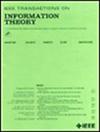On Minimal Pseudocodewords of Binary Hamming Codes
IF 2.2
3区 计算机科学
Q3 COMPUTER SCIENCE, INFORMATION SYSTEMS
引用次数: 0
Abstract
Pseudocodewords, and in particular minimal pseudocodewords, play an important role in understanding the performance of linear programming (LP) decoding. In this paper, we investigate minimal pseudocodewords of binary Hamming codes described by full-rank parity-check matrices. We first provide some general results on minimal pseudocodewords with support size 3 of a binary parity-check matrix. We also prove a lower bound on the minimum binary symmetric channel (BSC) pseudoweight of a binary parity-check matrix. Then we prove that a full-rank parity-check matrix of a binary Hamming code has minimal pseudocodewords of certain types whose support sizes are larger than 3. Interestingly enough, the BSC pseudoweight of all these minimal pseudocodewords is 2. Using this fact as well as the above-mentioned lower bound, we further prove that a full-rank parity-check matrix of a binary Hamming code has minimum BSC pseudoweight 2. Moreover, the additive white Gaussian noise channel (AWGNC) pseudoweight of all these minimal pseudocodewords is 3. Based on numerical observations, we conjecture that a full-rank parity-check matrix of a binary Hamming code has minimum AWGNC pseudoweight 3. Finally, we provide more properties of a subset of minimal pseudocodewords of a full-rank parity-check matrix of a binary Hamming code.伪码,尤其是最小伪码,在了解线性规划(LP)解码性能方面发挥着重要作用。本文研究了全秩奇偶校验矩阵描述的二进制汉明码的最小伪码。我们首先提供了一些关于二进制奇偶校验矩阵支持大小为 3 的最小伪码的一般结果。我们还证明了二进制奇偶校验矩阵的最小二进制对称信道(BSC)伪权的下限。有趣的是,所有这些最小伪码的 BSC 伪权都是 2。利用这一事实和上述下界,我们进一步证明了二进制汉明码的全阶奇偶校验矩阵具有最小 BSC 伪权 2。此外,所有这些最小伪码的加性白高斯噪声信道(AWGNC)伪权都是 3。基于数值观察,我们猜想二进制汉明码的全等级奇偶校验矩阵具有最小 AWGNC 伪权 3。最后,我们提供了二进制汉明码全等级奇偶校验矩阵的最小伪码子集的更多特性。
本文章由计算机程序翻译,如有差异,请以英文原文为准。
求助全文
约1分钟内获得全文
求助全文
来源期刊

IEEE Transactions on Information Theory
工程技术-工程:电子与电气
CiteScore
5.70
自引率
20.00%
发文量
514
审稿时长
12 months
期刊介绍:
The IEEE Transactions on Information Theory is a journal that publishes theoretical and experimental papers concerned with the transmission, processing, and utilization of information. The boundaries of acceptable subject matter are intentionally not sharply delimited. Rather, it is hoped that as the focus of research activity changes, a flexible policy will permit this Transactions to follow suit. Current appropriate topics are best reflected by recent Tables of Contents; they are summarized in the titles of editorial areas that appear on the inside front cover.
 求助内容:
求助内容: 应助结果提醒方式:
应助结果提醒方式:


